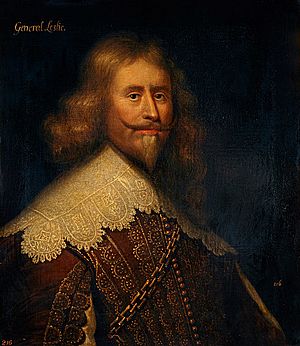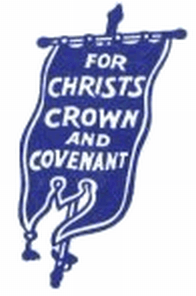Alexander Leslie, 1st Earl of Leven facts for kids
Quick facts for kids
Alexander Leslie, 1st Earl of Leven
|
|
|---|---|

Sir Alexander Leslie
|
|
| Born | c. 1580 |
| Died | 4 April 1661 (aged 80–81) Balgonie Castle, Fife, Scotland |
| Allegiance | |
| Years of service | c. 1605 – 1647 |
| Rank |
|
| Commands held | Army of the Weser Army of Both Kingdoms Army of the Solemn League and Covenant |
| Battles/wars | Thirty Years' War
|
| Spouse(s) | Agnes Renton (died c. 1651) |
| Children | Gustavus Alexander Barbara Christian Anne Margaret Mary |
Alexander Leslie, the 1st Earl of Leven (around 1580 – 4 April 1661), was a famous Scottish soldier and leader. Even though he was born outside of marriage and raised by another family, he became a top military commander. He rose to be a Field Marshal in the Swedish Army. In Scotland, he led the Covenanters' army and became a powerful figure. He also commanded armies in England during the English Civil War. Leslie fought in several big wars, including the Thirty Years' War and the Bishops' Wars. He lived a long life, reaching about 80 or 81 years old.
Contents
Early Life and Family
Alexander Leslie was born in 1580. His father was George Leslie, a captain at Blair Castle. Alexander was part of the Clan Leslie.
When he was young, Alexander was raised by the Campbell family of Glenorchy. This was called "fosterage" and created a strong bond. This connection also linked him to the powerful House of Argyll.
Military Career Abroad
Alexander Leslie spent many years serving in armies outside Scotland. He became a highly respected soldier.
Serving in Sweden
In 1608, Leslie joined the Swedish army. He quickly showed great skill and bravery. In 1627, the Swedish king made him a knight. The king, Gustavus Adolphus, especially liked and trusted Leslie.
In 1628, Leslie became the governor during the Siege of Stralsund (1628). He successfully defended the town against a powerful army. This battle was very important as it marked Sweden's entry into the Thirty Years' War.
In 1630, Leslie captured the island of Rügen for Sweden. In 1631, he helped organize English and Scottish troops for the Swedish army. He was then promoted to Major-General.
Leslie was injured in 1632 but was still present at the Battle of Lützen (1632). In 1636, he became a Field Marshal, one of the highest ranks. He was also a commander at the Battle of Wittstock that same year. This was a huge victory for the Swedish forces.
Leslie was very upset with another commander, Johan Banér, after the Battle of Wittstock. He felt he had to sacrifice many of his best soldiers to save Banér's men. Leslie even thought about leaving the Swedish army. But he was convinced to stay and reorganize his forces. By 1637, he was preparing to retire from Swedish service. He always remembered King Gustavus Adolphus fondly.
Return to Scotland
The Bishops' Wars
In 1638, events in Scotland called Leslie home. He was made "Lord General" of the Army of the Covenant. This army was formed by Scottish Presbyterians who wanted to protect their church. Many of its officers were experienced soldiers who had served with Leslie in Sweden.
Leslie helped bring cannons and muskets from Sweden as "gifts" for his pay. This helped equip the Scottish army. One of his first actions was to lead 6,000 soldiers to Aberdeen, a town that supported the King.
Leslie's reputation as a clever and skilled commander grew. He captured Edinburgh Castle without losing a single soldier. In the First Bishops' War, he led his army to Dunse Law. Instead of fighting the King's forces, he invited their officers to dinner. After seeing Leslie's well-trained army, the King's forces decided not to fight.
In the Second Bishops' War, Leslie led a brilliant campaign in northern England. He defeated the King's forces at the Battle of Newburn. He then easily took Newcastle. This put pressure on King Charles I to make peace with the Scottish Covenanters.
In 1641, King Charles I of England recognized Leslie's achievements. He made Leslie a member of the Scottish Privy Council. He also gave him the titles of Lord Balgonie and Earl of Leven. Leslie was also made captain of Edinburgh Castle.
The English Civil War
Leven later agreed to lead Scottish forces to help the English Parliament. This was part of the Solemn League and Covenant. This agreement united the Scottish and English parliaments against the King's forces.
In 1644, Leven led the Scottish army into England. They took part in the Siege of York. Then, he was the senior commander at the Battle of Marston Moor. His forces, along with two English armies, crushed the Royalist army led by Prince Rupert. After this victory, York surrendered. Later, Newcastle also fell after a tough siege.
In 1645, after his English allies won the Battle of Naseby, Leven tried to capture Hereford. But his siege was not successful. In 1646, King Charles I surrendered to Leven's army at Newark. Leven handed the King over to his allies. He only gave up his garrisons in northern England after his troops were paid all the money they were owed. In January 1647, Leven led his army back to Scotland.
After this, Leven retired from active military command. He was captured in 1651 by Cromwell's soldiers and sent to the Tower of London. He was later released. The Queen of Sweden, Queen Christina of Sweden, helped him gain his freedom.
In one of his last military actions, Leven helped his son-in-law raise troops for the Swedish army. These soldiers were mostly Scottish prisoners of war.
Alexander Leslie died in 1661 at Balgonie Castle in Scotland.
Family Life
Alexander Leslie was married to Agnes Renton. They had two sons and five daughters. His eldest son, Alexander, also became a colonel in the Swedish Army. He later fought alongside his father in the Army of the Solemn League and Covenant. Sadly, his son passed away before him.
Nursery Rhyme and Song
Some people believe the nursery rhyme "There Was a Crooked Man" is about Sir Alexander Leslie:
There was a crooked man and he walked a crooked mile,
He found a crooked sixpence upon a crooked stile.
He bought a crooked cat, which caught a crooked mouse. And they all lived together in a little crooked house.
A song called "General Lesley's March" was sung by Scottish soldiers in the 1640s. It might have been a playful song about the Covenanters:
When to the kirk we come,
We'll purge it ilka room,
Frae popish relics, and a' sic innovation,
That a' the world may see,
There's nane in the right but we,
Of the auld Scottish nation.
See Also
Images for kids





